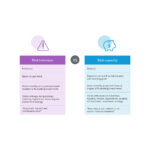Economic downturns are an inevitable part of the financial cycle. Whether triggered by inflation, war, a financial crisis, or a global pandemic, recessions can create fear, market volatility, and significant portfolio losses.
But while you can’t control the economy, you can control how you manage risk during uncertain times. The investors who survive—and even thrive—during downturns are those who plan ahead, stay calm, and make strategic decisions.
In this blog, we’ll explore:
- What an economic downturn really is
- Why managing risk is essential during these periods
- Actionable strategies to protect and position your portfolio
- The biggest mistakes to avoid
- Historical lessons from past recessions
What Is an Economic Downturn?
An economic downturn occurs when a country’s GDP slows or contracts, often accompanied by:
- Rising unemployment
- Declining consumer spending
- Falling business profits
- Bear markets (20%+ drops in stock prices)
In the U.S., a recession is often declared when the economy experiences two consecutive quarters of negative GDP growth.
Why Risk Management Matters More Than Ever
During a bull market, risk can feel distant. But during a downturn:
- Stock volatility spikes
- Safe-haven demand increases
- Liquidity can dry up
- Emotions override logic
Investors who aren’t prepared may panic-sell, lock in losses, or take unnecessary risks trying to recover too quickly.
That’s why a solid risk management strategy is critical—not just to survive the storm, but to emerge stronger.
Smart Risk Management Strategies for Downturns
Here are proven ways to manage financial risk during an economic slowdown:
1. Review and Adjust Your Asset Allocation
Your portfolio mix should reflect both your risk tolerance and the changing market conditions.
- Shift from high-volatility assets (growth stocks, emerging markets) to more defensive sectors (utilities, healthcare, consumer staples).
- Consider increasing your bond allocation for stability.
- Use target-date or balanced funds if you prefer a hands-off approach.
Rebalancing helps ensure your portfolio doesn’t become unintentionally risky after a market decline.
2. Build and Maintain an Emergency Fund
Cash is king during economic downturns. An emergency fund:
- Helps you cover unexpected expenses
- Prevents you from selling investments at a loss
- Reduces reliance on high-interest debt
Aim for 6–12 months of essential expenses in a high-yield savings or money market account.
3. Avoid Panic Selling
Emotions can ruin your investment strategy faster than any market crash.
- Remember: Downturns are temporary. Historically, markets have always recovered.
- Selling at the bottom locks in losses and eliminates your ability to benefit from rebounds.
- Instead, consider dollar-cost averaging or even adding to your portfolio at lower prices.
4. Diversify Across Asset Classes and Sectors
Diversification is the original form of risk control.
- Mix stocks, bonds, real estate, commodities, and cash equivalents.
- Spread across different industries (tech, healthcare, energy, etc.).
- Consider international exposure to reduce country-specific risk.
A well-diversified portfolio can reduce the impact of a single economic event.
5. Focus on Quality Investments
In tough times, strong companies survive—and often gain market share.
Look for:
- Low-debt companies with strong cash flows
- Dividend-paying stocks with consistent track records
- Firms in non-cyclical industries that offer essential goods/services
These businesses tend to be more resilient in a recession.
6. Use Stop-Loss Orders and Hedging (Advanced)
If you’re an active trader, you may use:
- Stop-loss orders to automatically sell if a stock falls below a certain level
- Put options to protect downside
- Inverse ETFs to hedge against falling markets
Use these tools with caution—while they can limit losses, they can also limit gains or increase complexity.
7. Reevaluate Your Financial Goals and Timeline
During downturns, it’s wise to:
- Delay major discretionary purchases
- Reassess your retirement withdrawal rate if you’re retired
- Adjust short-term investment plans if needed
Stay flexible. Markets change—and so should your approach.
What Not to Do During a Downturn
Avoid these common mistakes:
| Mistake | Why It’s Risky |
|---|---|
| Panic Selling | Locks in losses and misses future rebounds |
| Chasing “Hot” Investments | High-risk assets may crash harder |
| Ignoring Diversification | Concentrated portfolios are more volatile |
| Taking On Excessive Debt | Can magnify financial stress during uncertainty |
| Timing the Bottom | Even professionals rarely get it right |
Historical Lessons: What We’ve Learned
2008 Financial Crisis
- Markets dropped over 50%, but fully recovered by 2013.
- Investors who stayed invested saw significant gains.
2020 COVID-19 Crash
- Sharp 30% drop followed by one of the fastest bull runs in history.
- Reinforced the value of not panic selling.
Dot-Com Bubble (2000)
- Tech-heavy investors faced huge losses.
- Highlighted the need for sector diversification and caution with speculation.
These past events show that downturns are painful—but also full of opportunity for patient, risk-aware investors.
Final Thoughts: Survive and Thrive
Managing risk during economic downturns isn’t about predicting the future—it’s about being prepared for it.
The investors who do best during recessions:
- Stay calm
- Remain diversified
- Focus on long-term goals
- Protect their cash flow
- Look for smart buying opportunities
At WealthinStock.us, we’re here to help you navigate every phase of the market with confidence, clarity, and smart strategies that work.


